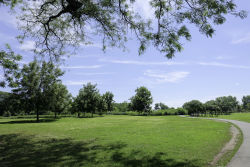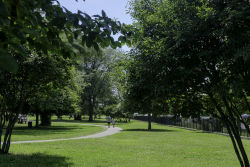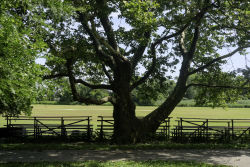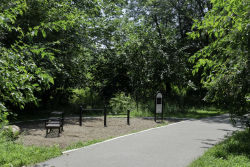Canarsie Park
Canarsie Park
What was here before?
The Canarsie resided here for thousands of years and called the area now known as the Flatlands, Keskateuw. Their planting lands were located north of this site, extending to Avenue J.
With the arrival of the Dutch, fighting and disease killed much of the local Canarsie population. Settlers documented that the Canarsie traded and sold them the land. This site was originally deeded to Samuel Spicer by the Canarsie in 1664 who in turn sold it to Elbert Elbertse Stoothoff. In 1675 it was bought by Jan Martense Schenck (1640-1689), who arrived from Holland and settled in Breuckelen (Brooklyn) in 1650. He amassed a large tract of land that remained in his family for generations.
Nicholas Schenck (1732-1810), grandson of Jan Martense Schenck and a Captain in the local militia during the American Revolutionary War, built a one-and-one-half-story farmhouse with a gambrel roof between 1770 and 1775 within the current boundaries of this park.
How did this site become a park?
From 1895 to 1896 the City of Brooklyn purchased land for Canarsie Park. Brooklyn Parks Commissioner Frank Squier stated that “this [Schenck] house will be preserved and will always be one of the Park’s attractions.” However, the house was dismantled and removed from the park in 1952. It was assembled at the Brooklyn Museum of Art and opened to the public in 1964.
The park originally stretched from 93rd Street to 88th Street, and from Seaview Avenue to Skidmore Avenue. It was extended in 1934 with land from the Department of Docks and in 1938 and 1949 with parcels from the Board of Estimate. In the 1950s Parks Commissioner Robert Moses requested the transfer of land that had been used for temporary housing during World War II to expand Canarsie Park. Property at the corner of Fresh Creek Basin and Seaview Avenue was assigned to Parks in 1958. Most of the city parkland south of the Shore Parkway was transferred to the National Park Service for the creation of Gateway National Recreation Area.
There was once a carousel that was carved in 1912 by Gold and Goldstein for Golden City Park that was an amusement park that existed on these grounds.
The playground was built in 1936 and renovated in 1995-97. It was named for Joseph F. DiNapoli, a former Principal Parks Supervisor of Canarsie Park, in 1990.
Who is this park named for?
Canarsie Park and its neighborhood take their name from the Indigenous Canarsie (or Canarsee), who lived in western Long Island and were related to the Delaware. They called this area Keskachauge or Kestateuw, but the Dutch renamed it New Amersfoort soon after they settled here in the 1630s.
Check out your park's Vital Signs
Clean & Safe
Green & Resilient
Empowered & Engaged Users
Share your feedback or learn more about how this park is part of a
Vital Park System










